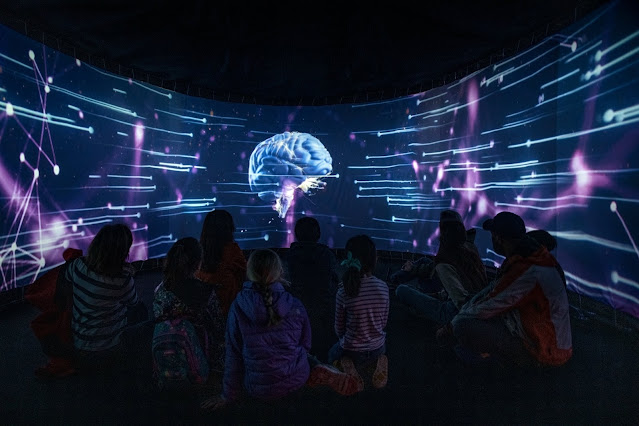The 173rd birthday of Santiago Ramón y Cajal (1852–1934) will occur on May 1, 2025.
I celebrate his birthday as he continues to influence brain science through both his groundbreaking scientific work and his remarkable visual creativity.
For over a decade, I’ve explored the intertwined relationship between art, identity, and science through the legacy of Cajal. My first encounter with his drawings—those haunting, gestural renderings of neurons—was nothing short of transformational. I wasn’t yet aware of his stature in neuroscience. I simply saw drawings that felt alive, breathing in implied space, extending thought through line. What struck me was not just their anatomical accuracy, but the deep perceptual observation embedded within them. Unlike the topographical containment of Camillo Golgi’s work, Cajal’s drawings seemed discovered, not designed—a collaboration between eye, hand, and wonder.
This journey led me across disciplines and continents, including a Fulbright España Senior Research Fellowship at the Instituto Cajal in Madrid. It also shaped my long-term visual art project Aesthetic Instincts: The Intersection of Art and Science in the Life of Santiago Ramón y Cajal—a body of work that fuses historical research, observational drawing, surreal imagery, and personal interpretation.
Santiago Ramón y Cajal, drawing of the spinal cord of a newborn dog, in contrasting colors, ink, and graphite on paper, 1894, 12 × 15 in. The drawing uses colors that differ from those of the stains in the original histologic specimens. This drawing was reproduced (SR Cajal 1895) with the following color codes: neuroglia in brown, nerve cells in blue, fibers that cross the gray substance in red, and the collaterals and fibers of the white substance in black. Ependymal cells are also colored in brown. Image courtesy of the Archivo científico Fernando de Castro.
I'm honored to have two recent publications that explore these ideas:
"Art, Intuition, and Identity in Ramón y Cajal" — published in The Neuroscientist (Vol. 31, Issue 2, April 2025), co-authored with Javier DeFelipe, Arpan R. Mehta, and Bevil R. Conway. This essay examines how Cajal’s artistic training and aesthetic choices were central to his scientific legacy. His self-fashioning through drawing and photography, his use of metaphor and allegory, and his Dürer-inspired visual strategies all reveal a man who did not separate science from selfhood. Read the article here: https://journals.sagepub.com/doi/full/10.1177/10738584241234049
"Drawn To, Drawn From Experience" — featured in the newly released book Circulating Now, Full Circle, published by Virginia Tech and the National Library of Medicine. My essay (pp. 229–235) explores my first encounter with Cajal’s drawings and the phenomenological experience of discovery—what it means to see something new not through data, but through presence. It’s part of a larger conversation about how historical archives can ignite both research and imagination.
As Cajal once wrote, "Only artists devote themselves to science." He believed that beauty and intuition were not embellishments, but essential instruments of discovery.
His life reminds us that seeing—truly seeing—is an act of synthesis. It draws on memory, biology, curiosity, and love.
On May 1st, I will, as every year, celebrate Cajal not only as the father of modern neuroscience, but as an artist of perception, and as a kindred spirit whose drawings continue to shape the contours of my own work, both in studio and in scholarship.
Portrait of Santiago Ramón y Cajal from my handmade sketchbook. Pen, ink and collage on paper.
Circulating Now, Full Circle is available through Virginia Tech Publishing and most major booksellers.
The Neuroscientist, April 2025 issue can be accessed here: Volume 31 Issue 2, April 2025
Follow more of my work at www.dawnhunterartist.com.
Dawn Hunter, Illustration of Cajal’s Information Flow in the Retina scientific drawing, marker and pen on paper, 11" x 14"
The vertebrate retina is another good example of Cajal’s Law of Dynamic Polarization. Because he knew from which direction the stimulus to the photoreceptors (at the top of the diagram) originated, it was clear that information ought to be transmitted inwards, through axons of the photoreceptors to the dendrites of the horizontal and ganglion cells, and onward into the visual cortex, as noted by the arrows on the diagram above. In addition to the usual retinal information flow, Cajal illustrated some more unusual directions for information transmission. He noted information flowing from c to I, along the cell body of a horizontal cell, although this subsequently has not been found to be a viable signal path. Likewise, visual signals in many amacrine cells, shown to the right of D, need not pass through the cell body, contradicting the apparent intent of Cajal’s arrows. While Cajal may have erred in these two instances, he correctly observed another unusual signaling pathway between G and H: these axons from the visual cortex are returning to the retina and transmitting information to the amacrine cells. This phenomenon has indeed been observed in present day, but not in all vertebrates; significant centrifugal input is a hallmark of avian eyes in particular.




















